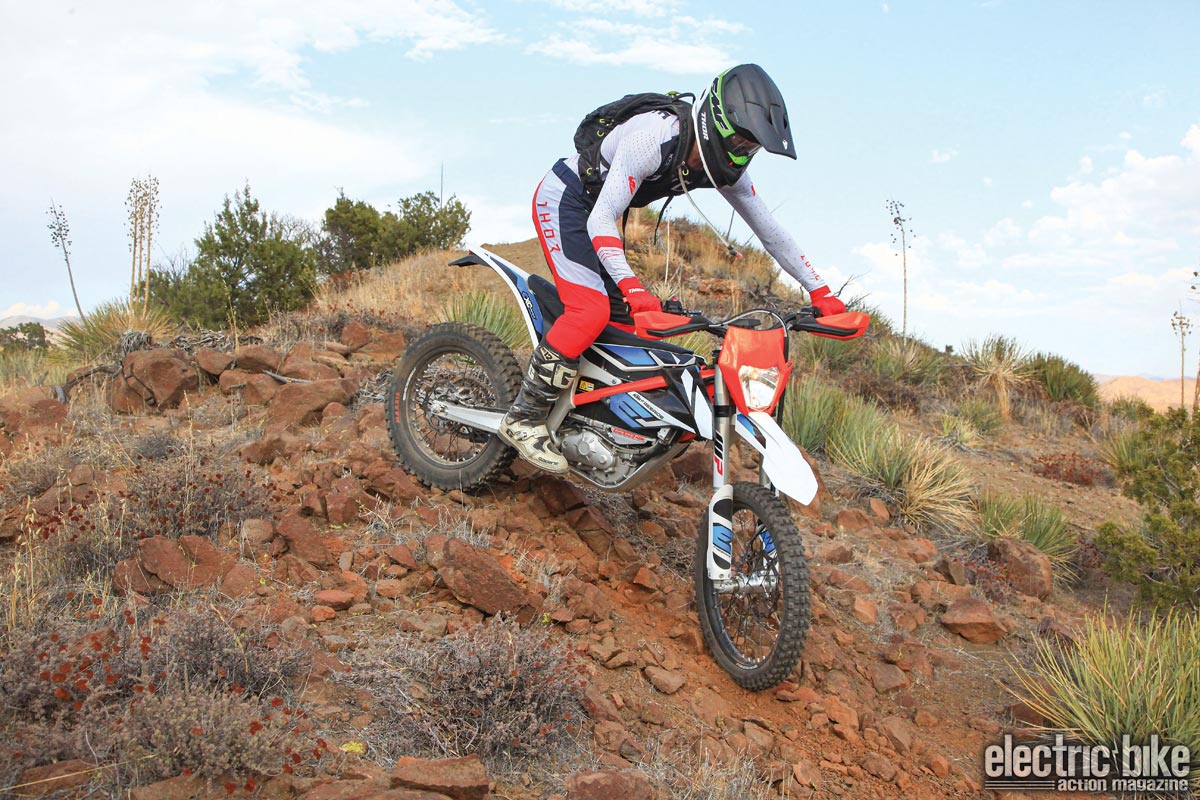
Photos: Pat Carrigan and Karel Kramer
KTM is a famous Austrian motorcycle brand that got its start in 1954, and in the years since (from MotoGP to motocross tracks around the globe) has become synonymous with gas-driven, championship-winning motorcycles—until now! Sur-Ron, on the other hand, has been gaining popularity in the last few years as a more affordable option and potentially just as effective for the right person.
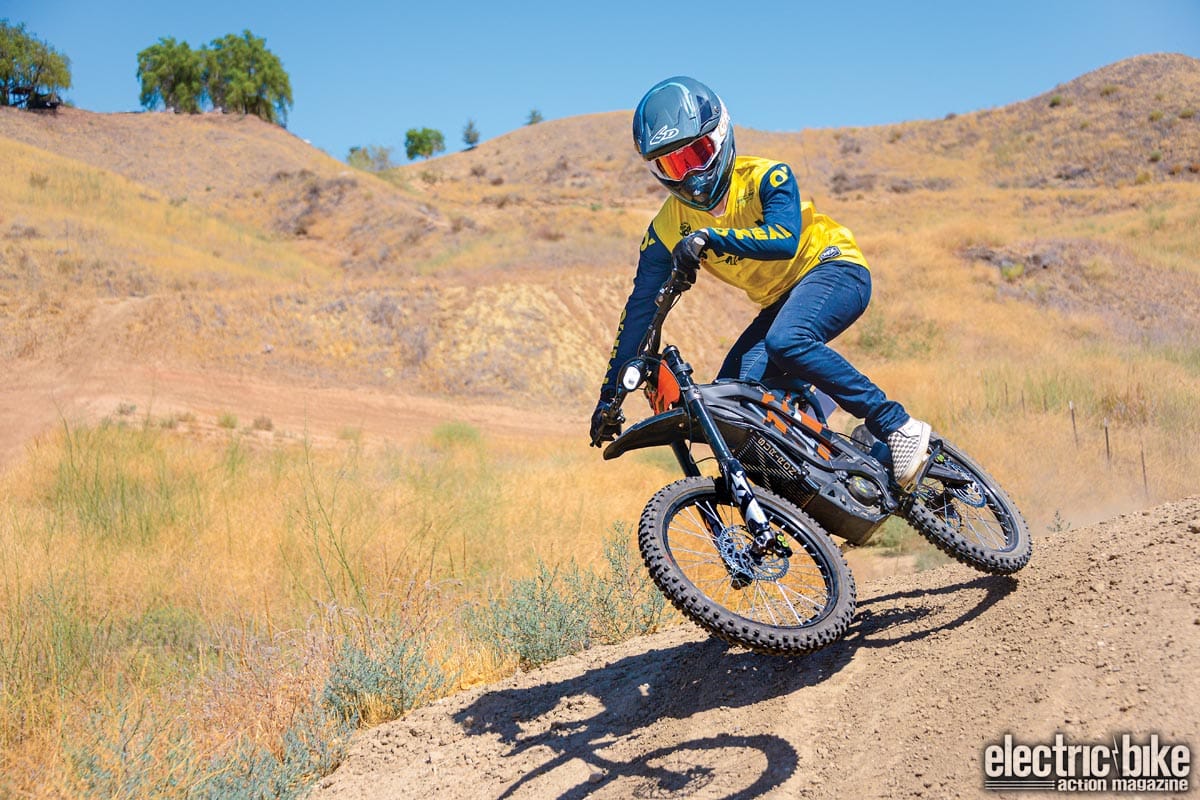
One could easily say it’s a lopsided comparison on the surface. Sure, the Sur-Ron is substantially smaller than the KTM, but the two machines have more in common than meets the eye. Not so much in price, name recognition or size, but more in terms of being practical, silent machines low on the neighborhood-annoyance scale with minimal maintenance required. That is, compared to a typical off-road gas-powered bike.
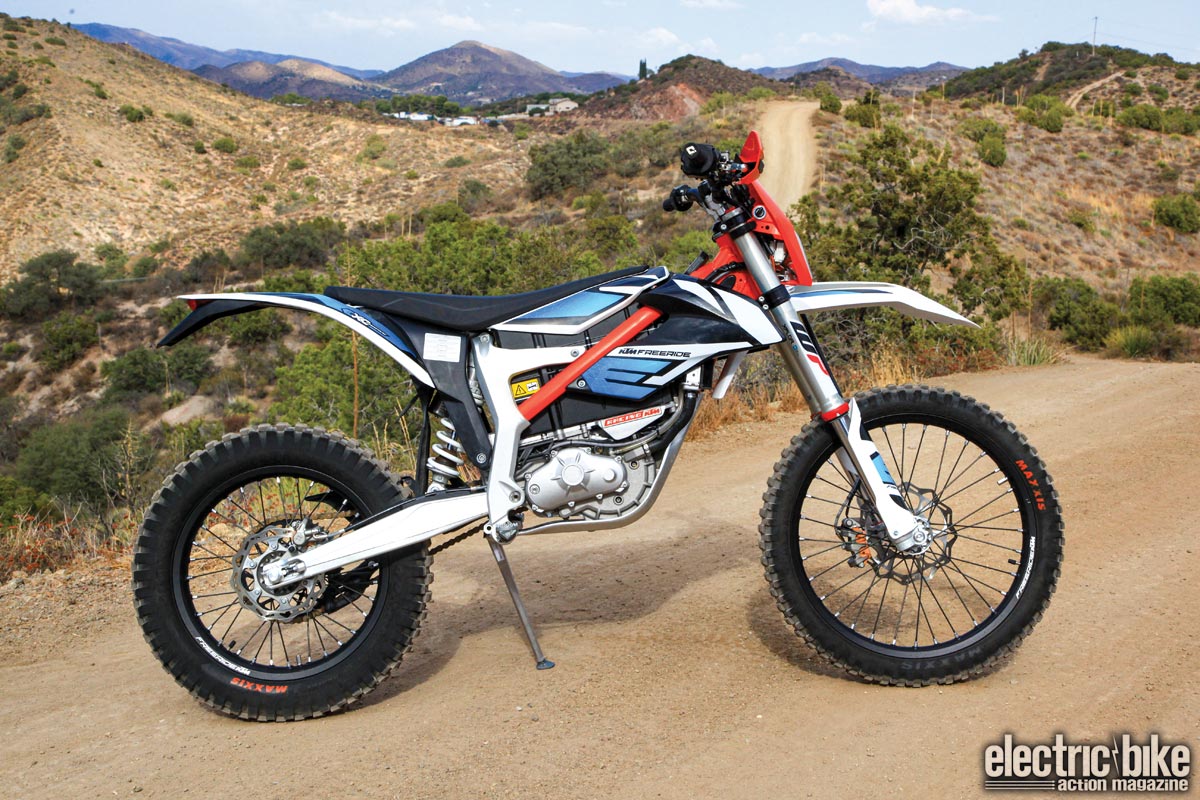
For the motorcyclists out there with no time on electric bikes, it can be hard not to compare these new-age e-moto bikes to the gas-powered bike you grew up riding. It’s worth noting, these are not race bikes, but more so entry-level beginner bikes that can still do big things with a capable rider.
THE BIKE
KTM Freeride E-XC
The Freeride utilizes three separate frame sections, along with a hard-plastic subframe. The forged-aluminum swingarm pivots on the aluminum back section of the frame. The back section is bolted onto the top front portion of the frame, which is steel. Those two sections use the motor itself with the third section acting as an integral part of frame support. This setup merges the three pieces into one strong assembly.
The battery is cradled directly above the electric motor centered between the two top frame pieces, which makes it slightly top-heavy compared to traditional bikes. You can feel it when loading it up or leaning it over. And while we’re talking weight, although not physically bigger, at 245 pounds, the Freeride is roughly 10 pounds heavier than a full-size KTM 300cc two-stroke motorcycle. The wheelbase is 55.8 inches, with the seat height measuring 35.8 inches.
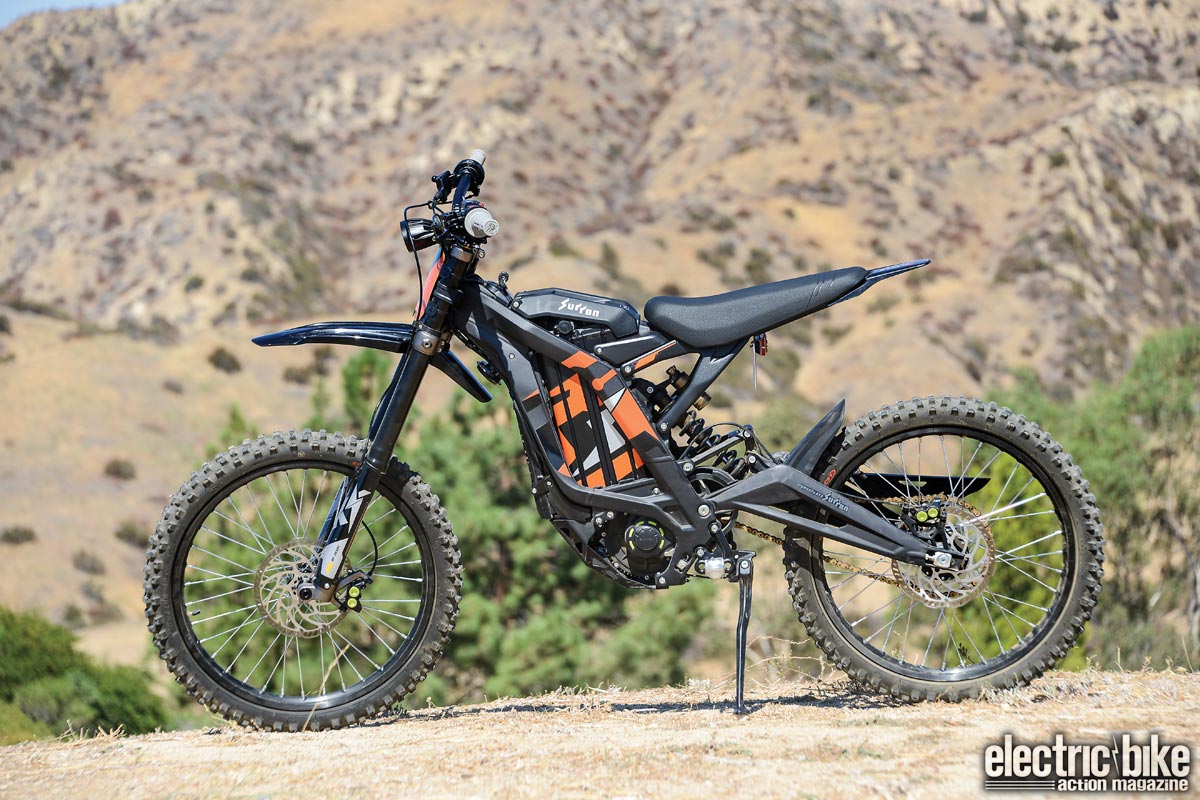
KTM supplies you with an impressive charging unit that includes a storage charging mode, which stops charging before the battery is full. That function is for when you don’t plan on riding for an extended period of time. The second mode is normal, and third is fast charging. The one caveat that needs to be mentioned is that the KTM requires a 220-volt hook-up. Although the bike is supplied with an L6-20 male-end 220-volt plug, it was still frustrating. For the sake of testing, we had an electrician install that L6-20-style outlet in our garage.
However, a much cheaper and simpler option would be to get an L6-20 plug to use with the more common 14-30 standard adapter. This is slightly frustrating, but you’ll have to adapt if you want a KTM Freeride. Not to mention, when you go to charge it for the first time, you’ll be happy to find out it only takes around an hour to fully charge.
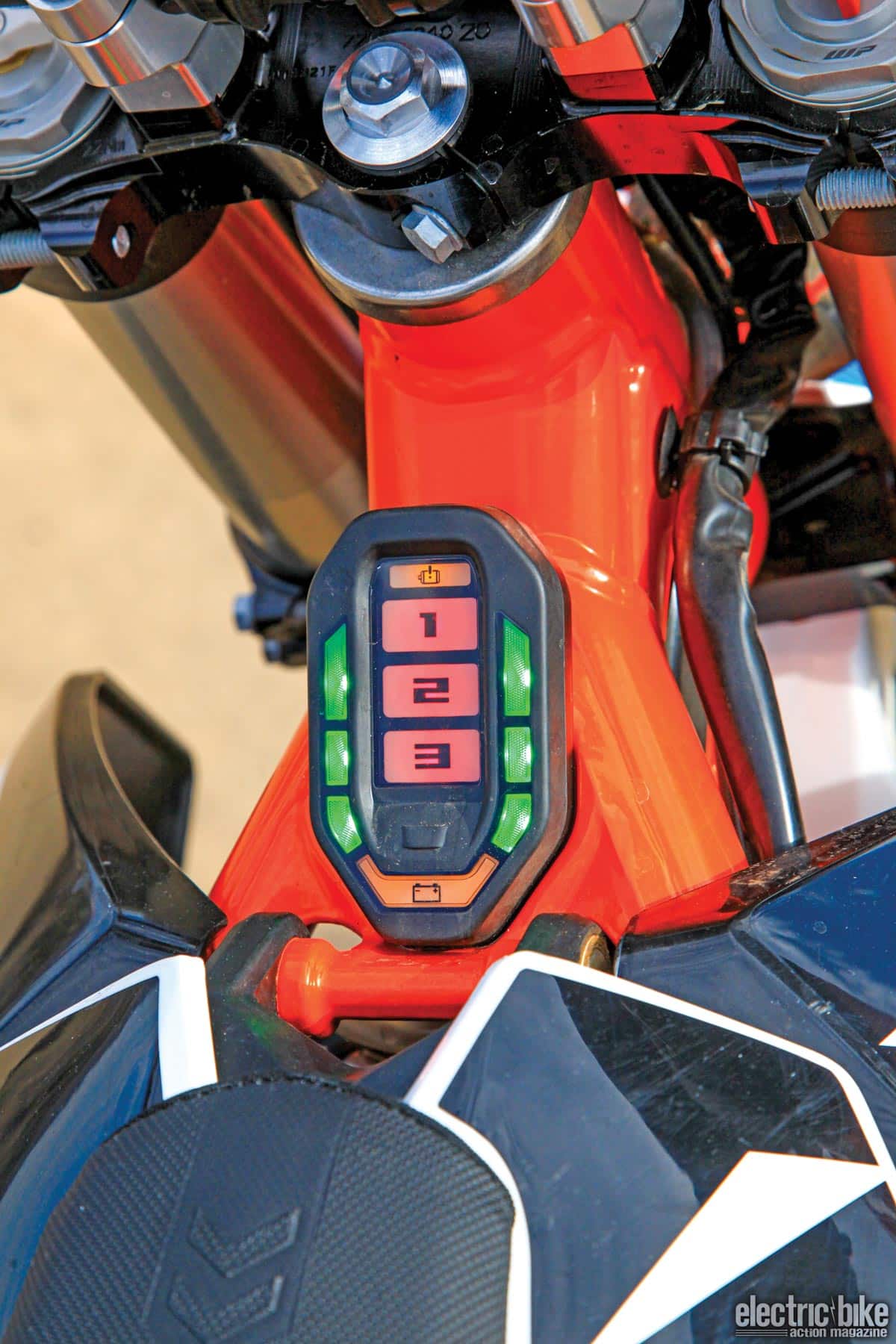
Sur-Ron Light Bee
The aluminum swingarm pivots on the forged-aluminum frame and utilizes a Sur-Ron-developed linkage for the rear suspension. The motor sits in the lower middle section of the frame, and mounted directly on top is the rectangular battery. The battery is removed by using the key to remove a lid that locks it in place, and since the battery itself is not bolted in, the lid must be locked to prevent the battery from falling out.
THE PARTS
KTM Freeride E-XC
The KTM rolls on an 18-inch rear/21-inch front-wheel combo wrapped with Maxxis TrialMaxx tires that use a really soft rubber compound, which supplies you with extreme grip, particularly on harder surfaces.
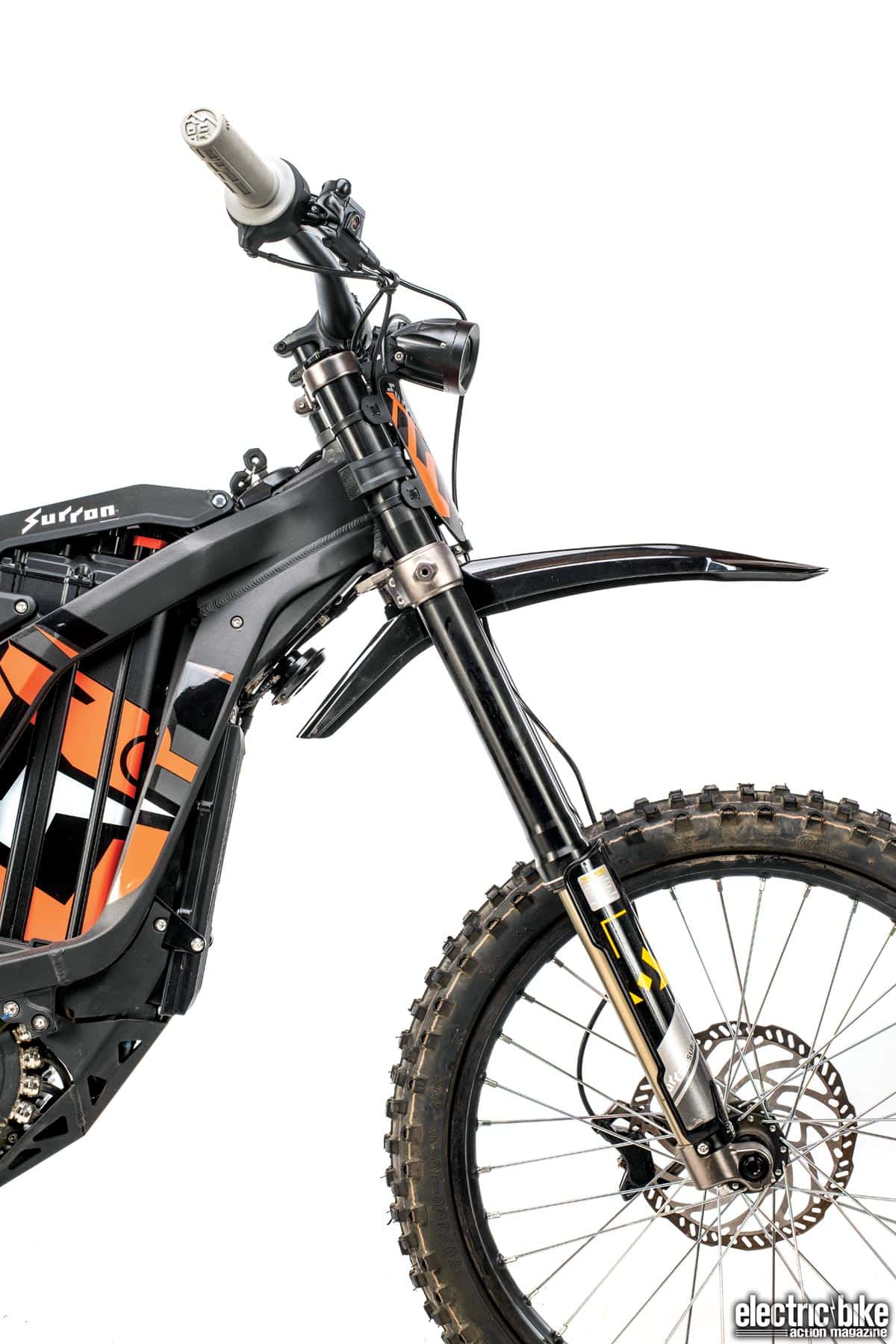
The non-linkage rear suspension starts with a 260mm-travel WP XPLOR rear shock. It’s a simpler design, which is
aided by a progressive rate spring to help keep the bike balanced. Up front is a 43mm WP XPLOR fork with 250mm of travel. One fork tube has rebound damping, and the other controls compression.
“While there are a few internal combustion engine bikes you could try to compare these two to, for the most part they present a completely new flavor of fun and possibility.”
The cockpit is comprised of aluminum handlebars with ODI grips and plastic handguards. Directly in front of the handlebars is an odometer, speedometer and hour meter with built-in warning codes. That display module lights up only when triggered by the spinning front wheel.
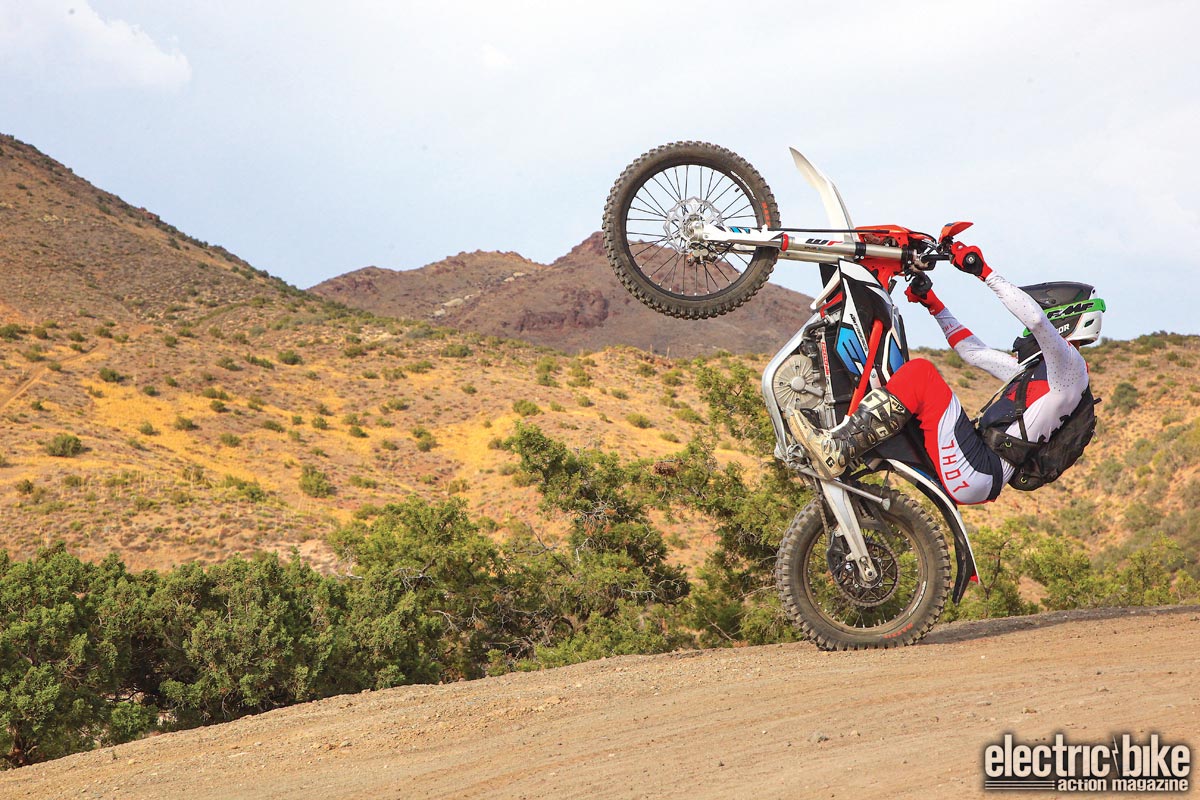
Instead of a foot-pedal rear brake, the Freeride mimics a mountain bike setup with a hand-lever brake on the left side of the handlebar. You can easily replace the hand-lever brake with a bolt-on rear brake pedal if you would prefer. The front and rear Formula brakes utilize floating calipers. In the front is a double-piston setup, and the rear uses a single piston with 3.5mm-thick Galfer discs all around.
Apart from the main big battery that supplies power to the motor, the Freeride also uses a small auxiliary battery to run the headlight and taillight. They’re the same lights found on KTM’s other enduro/cross-country models with a high and low beam added to the headlight. Par for stock off-road KTMs, you’ll get basic protective guards for the chain, fork and countershaft sprocket. The motor has a thin aluminum skid plate that could easily be smashed if you bottom out on some big rocks or logs.
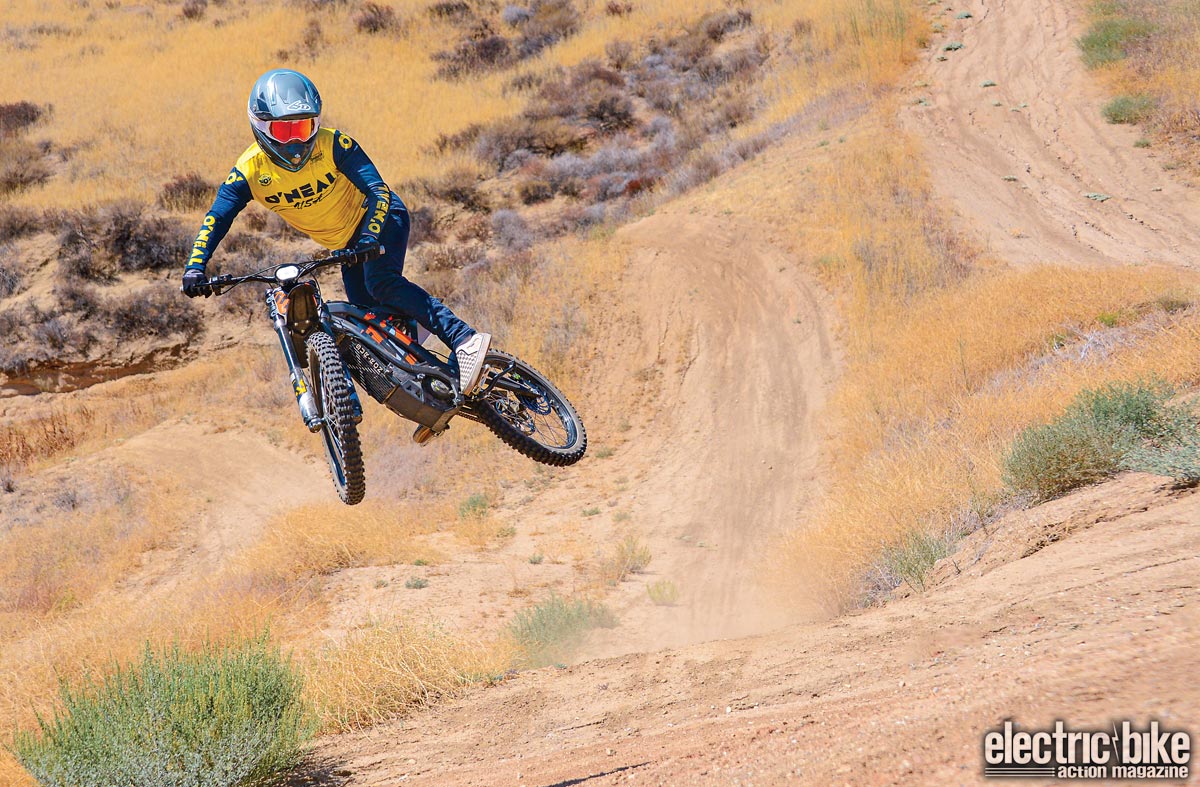
Sur-Ron Light Bee
Most full-size dirt bikes typically utilize a smaller rear/bigger front wheel combo, but not the Light Bee, which rolls on a pair 19-inch hoops mounted with CST 70/100 tires, which is more similar to a mountain bike.
“Although the Sur-Ron is substantially smaller in size than the Freeride, the two machines have more in common than meets the eye.”
For suspension duties you’ll find a 200mm-travel Sur-Ron shock and fork, which is about as much travel as you’d find on a downhill mountain bike. One of the weak points to the bike is the brakes. The Sur-Ron-branded double brakes rely on 203mm rotors, which are undersized for an e-motorcycle of this weight and size.

A kickstand is standard on the Light Bee, and when it’s in the down position, it kills the power to the rear wheel. That’s a great feature, because we’ve seen many people take off with kickstands down and it could be extremely dangerous. The pegs won’t be wearing your shoes out any time soon, as they are very low grip
and narrow.
“Sur-Ron, on the other hand, has been gaining popularity in the last few years as a more affordable option and potentially just as effective for the right person.”
For night riding, the Light Bee relies on a decent-sized LED headlight, as well as a small taillight. People who care about getting other people’s attention will do so as the horn is sufficiently loud. The drivetrain consists of a primary belt that turns a 14-tooth front sprocket, which then drives the 48-tooth rear sprocket with a standard 420
drive chain.
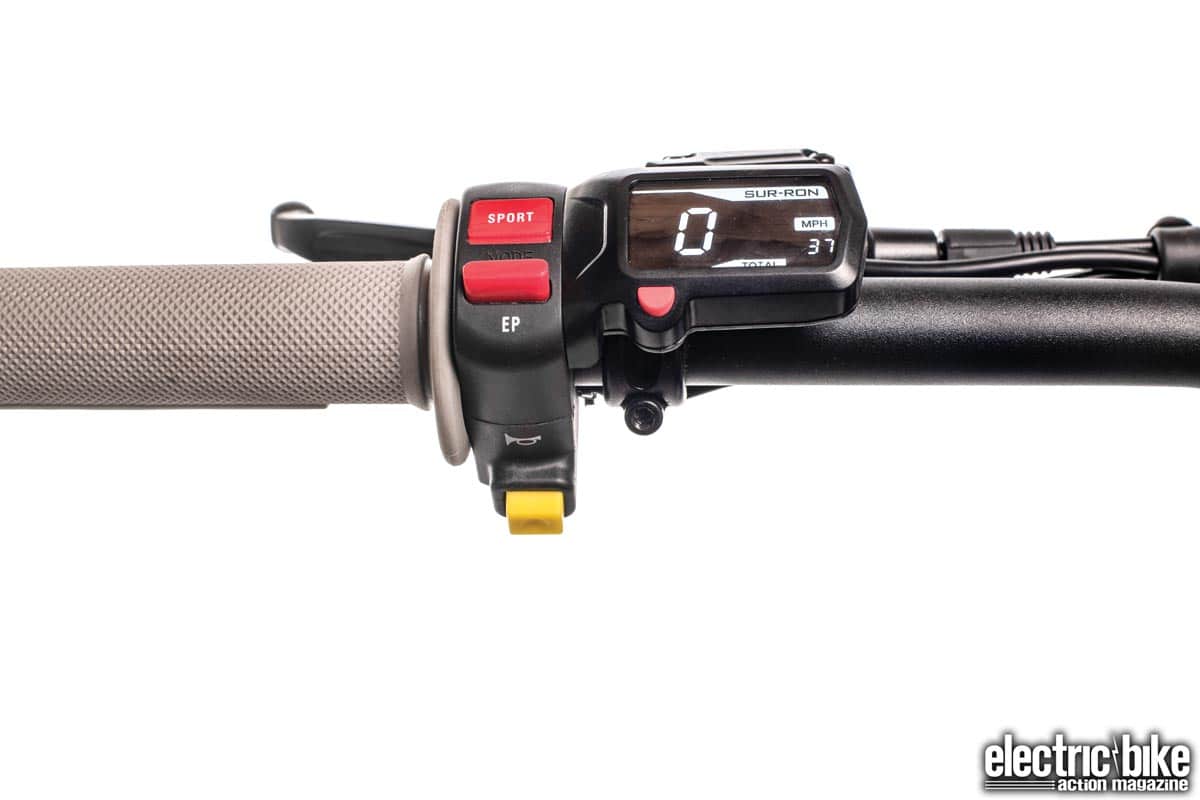
THE MOTOR
KTM Freeride E-XC
As you might guess, the drive unit is a fully automatic brushless electric motor that produces about 25 horsepower. The power mapping, although extremely smooth and plentiful, is delivered much differently than a gas-powered bike. In fact, it’s much more like a scaled-up version of the Sur-Ron with acceleration, particularly in the mid- to top-end part of the power, being enough to make you really grip the handlebars and get your adrenaline flowing! Top speed is 55 mph, but the acceleration getting there is incredible. The reason they left it sort of flat on the bottom end of the power is to make sure you can still achieve fair throttle control and minimize wheelspin in technical sections.
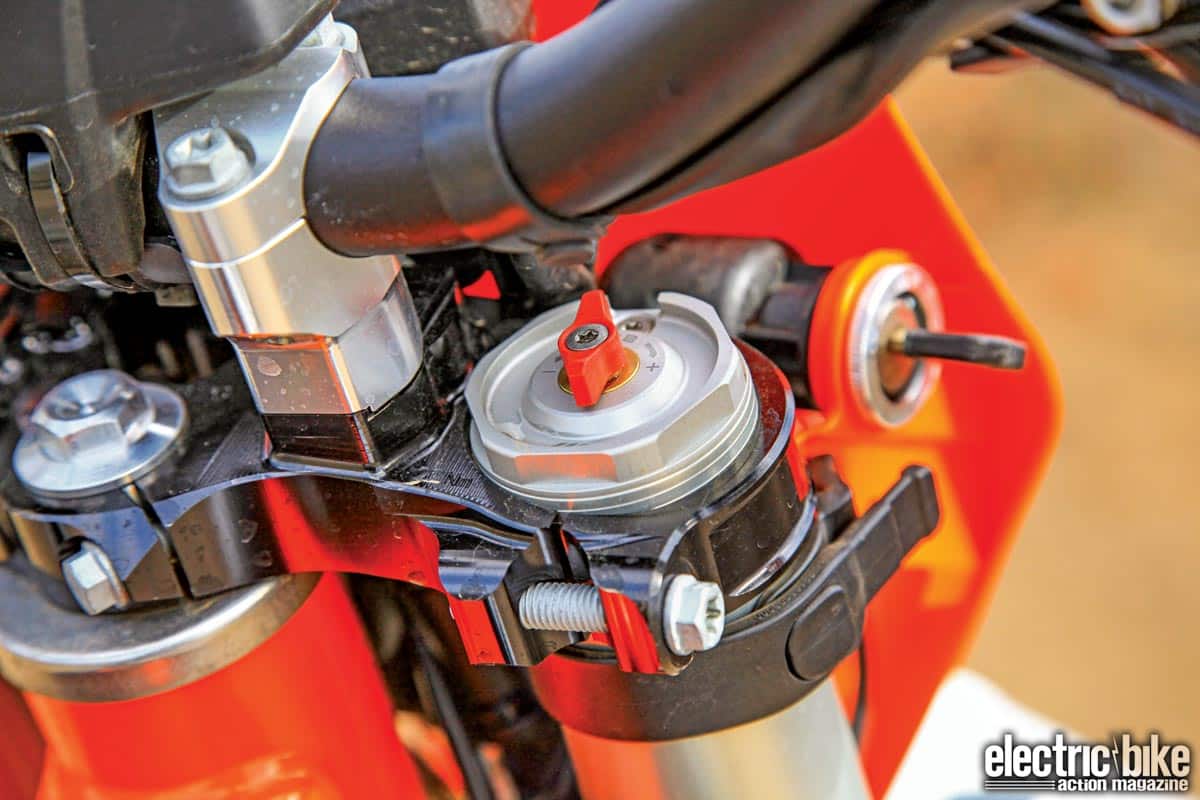
“By looking at it or sitting on it, you could compare the Light Bee to the size of an 85cc two-stroke motorcycle meant for kids between the ages of about 9 to 15.”
In order to keep the motor from overheating, the Freeride utilizes a liquid-cooling system. This adds a chunk of weight to the bike, but it’s worth it for the longevity of the electric drive system. KTM assured us that the whole bike can be submerged under water as the motor is completely sealed. We never submerged our test bike, but that’s an impressive feature for aspiring adventure (scuba?!) riders.

The 260-volt battery allows for about one to two hours of riding depending on what type of load you’re putting on it. We’ve found ourselves getting more than two hours just play riding in the driveway, but when we hit the trails and include hill-climbs, it’s somewhere closer to an hour. Of course, it does depends on which of the three power modes you choose. We found power level three to be the only one capable enough for real trail rides. Beginners that have never ridden will likely start riding in one or two to get their feet wet. A full recharge took just over an hour.
Sur-Ron Light Bee
Unlike the Freeride, the Light Bee is an air-cooled motor with only two power modes. Power delivery is strikingly similar to the Freeride in terms of the power curve and the immediate throttle response. The main difference being that the Sur-Ron is much less powerful with the motor being rated at 3000 watts.
“Smaller riders may not benefit from how heavy the Freeride is.”
We were able to get roughly one and a half hours of ride time with a full charge. Being smaller and less powerful, the Light Bee can’t really do the same type of riding the Freeride can. Ride time is highly circumstantial, like with any electric motor. This time it’s based off of the stock 60-volt, 32-amp lithium battery with 176 Panasonic cells. It takes roughly three hours to charge back to full status.
Don’t expect to be throwing huge rooster tails of dirt with this bike. In fact, getting the front end to pick up off the ground requires a fair amount of effort. Of course, with available modifications on the market, it’s a whole different story. There are companies dedicated to aftermarket batteries and controllers that can make the Light Bee scary fast.
WHO IT’S MADE FOR
KTM Freeride E-XC
Although the Freeride could be received by some as a sub-par alternative to a gas-powered dirt bike, it’s actually more complicated than that. First and foremost, it caters to beginners. It’s a more graceful and tame way for a new rider to experience motorcycle riding without requiring clutch control. Not to mention, the power is much easier to finesse than many ICE bikes, because it is always the same exact throttle response down to an almost atomic level.
We put some friends on it with no previous motorcycle experience, and an expression of joy was shared by all of them after their initial ride. You can’t stall an electric motor, which is noticeably relieving for new riders. However, they may not benefit from how heavy the Freeride is. For example, loading it into a truck or picking it up after a tip-over proved challenging.
Sur-Ron Light Bee
Our time spent on the Sur-Ron has proven that it’s a great bike for building off-road skills. We were able to attempt certain stunts that on a full-size motorcycle we would not have the confidence to try. Then again, it doesn’t need to be used in an extreme way at all to have fun on. Similar to the Freeride, the Light Bee has a strong appeal for beginner riders.
THE RIDE
KTM Freeride E-XC
Our first roll on the bike was such a unique feeling. No noise, no vibration, odorless and consistent throttle response. It hits your senses in a different way than any gas-powered bike can. We generally rode in the highest power level, as it was the most useful for everything we encountered. KTM uses a regenerative power system as well, and it resembles the way a four-stroke combustion engine feels when decelerating.
We spun some laps on KTM’s factory Supercross test track, along with their EnduroCross track. We hit a few smaller jumps on the Supercross track, but the suspension was so soft that we had to purposely avoid jumps where we couldn’t reliably place ourselves smoothly on the downside of the landings. Away from the track the bike did much better in mixed-terrain conditions, which makes sense because it was designed as a cross-country
trail bike.
The more time we spent riding, the more we noticed the weight of the bike. Most of the weight is in the battery, which makes it feel top-heavy as a result. And, as great as it can be for beginners, the power is plenty capable, but when trying to conquer more advanced trails with steep sections, we missed a clutch. That said, it is still very capable and got us up some fairly tricky terrain. In rare instances, though, we almost felt at an advantage having no clutch. The same was true for the rear brake being on the handlebars.
Sur-Ron Light Bee
We felt Sport mode was essential for all the riding we did, and honestly it was still quite tame on the initial part of the powerband. So, don’t expect to be shooting roost off the rear tire through corners. Ride time was impressive, though, and on average we could get an hour and a half or more out of it relatively easy. Like any electric bike, it depends on what type of riding you’re doing.
It does feel similar to a full-size bike in the ergonomics department, just scaled down. The weight of the Light Bee is balanced nicely, which made getting used to jumps relatively easy. Suspension performance was good, but if we started to push the speed through the rough stuff, it definitely felt soft.
THE VERDICT
In a way, the KTM doesn’t need much of any modifications right out of the gate, and you pay a big chunk of money for that complete package. However, a platform like the Sur-Ron that can be modified with some standard mountain bike components (Fox suspension and Shimano brakes) is what makes the potential of the Sur-Ron a unique machine. The Light Bee can be purchased for less than half the price of the Freeride while still being capable of providing a ton of fun.
While there are a few internal combustion engine bikes you could try to compare these two to, for the most part they present a completely new flavor of fun and possibility. We can say that our experience with it was void of any problems. We are certain both of these electric dirt bikes will invite a whole new crowd of enthusiasts to experience the thrill of riding motorcycles.
As for our desert island choice? We know full well of KTM’s reputation for making durable off-road bikes. The Sur-Ron held up well for the weeks of testing, but it’s a new brand to us, so we’re not so sure about it long-term. Still, knowing that 1. The Light Bee doesn’t require a 220-volt charge, and 2. That it could become a much more capable ride with both suspension and brake upgrades (and still cost thousands less than the KTM), we’d give the nod to the
Light Bee.
SPECS
KTM FREERIDE E-XC
Price: $11,099
Frame: Aluminum and steel
Fork: WP 43mm Xplor
Rear shock: WP Xplor PDS shock absorber
Motor: 9000 watts
Battery: 260V, 3900 Wh
Display: Multi-colored LED
Charge time: 1.3 hours
Top speed: 55 mph
Range: 1–3 hours
Chain: Regina 520
Brakes: Floating caliper Formula disc, double-piston front, single-piston rear
Rims: Giant 18-inch rear, 21-inch front
Hubs: Machined aluminum
Tires: Maxxis TrialMaxx
Weight: 245 pounds
Color choice: Orange/white
SPECS
SUR-RON LIGHT BEE
Price: $4400
Frame: Aluminum
Fork: Sur-Ron 200mm
Rear shock: Sur-Ron 200mm linkage system
Motor: 3000 watts
Battery: 60V 32A lithium
Display: Black and white, backlit
Charge time: 2.5-3.5 hours
Top speed: 45 mph
Range: 20–60 miles
Chain: 420
Brakes: Sur-Ron, double-piston calipers, 203mm rotors
Rims: Aluminum 19-inch
Hubs: Aluminum
Tires: CST 70/100-19 tires
Weight: 110 pounds
Color choice: Blue, white, black
Sizes: One size
The post KTM FREERIDE E-XC VS. SUR-RON LIGHT BEE appeared first on Electric Bike Action.
FOLLOW US on…
Facebook at /YourBestLifeGoods
Instagram at @YourBestLifeGoods
Twitter at @YBLGoods
Pinterest at YBLGoods
LinkedIn at YBLGoods

